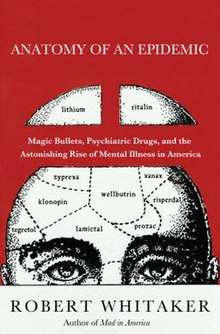Anatomy of an Epidemic
 |
|
| Author | Robert Whitaker |
|---|---|
| Original title | Anatomy of an Epidemic: Magic Bullets, Psychiatric Drugs, and the Astonishing Rise of Mental Illness in America |
| Published | 2010 (Crown Publishing Group) |
| Media type | |
| ISBN | |
| OCLC | 429022293 |
| 616.89 | |
Anatomy of an Epidemic: Magic Bullets, Psychiatric Drugs, and the Astonishing Rise of Mental Illness in America is a book by Robert Whitaker published in 2010 by Crown. Whitaker asks why the number of Americans who receive government disability for mental illness approximately doubled since 1987.
In the book, Whitaker tries to answer that question and examines the long-term outcomes for the mentally ill in the U.S.
Whitaker begins by reviewing the discovery of antipsychotics, benzodiazepines and antidepressants. These were discovered as side effects during research for antihistamines (specifically promethazine), gram negative antibiotics (specifically mephenesin) and the anti-tuberculosis agents isoniazid and iproniazid respectively. The psychiatric mechanisms of action of these drugs were not known at the time and these were initially called major tranquilizers (now typical antipsychotics) due to their induction of "euphoric quietude"; minor tranquilizers (now benzodiazepines) and psychic energizers (now antidepressants) due to patients "dancing in the wards." These compounds were developed during a period of growth for the pharmaceutical industry bolstered by the 1951 Durham-Humphrey Amendment, giving physicians monopolistic prescribing rights thus aligning the interests of physicians and pharmaceutical companies. This also followed the industry's development of "magic bullets" that treat people with, for example, diabetes, which according to Whitaker provided an analogy to sell the idea of these drugs to the public. It was not until many years later, after the mechanisms of these drugs were determined, that the serotonergic hypothesis of depression and dopaminergic hypothesis of schizophrenia were developed to fall in line with the drug's mechanisms. According to Whitaker's analysis of the primary literature, lower levels of serotonin and higher levels of dopamine "have proved to be true in patients WITH prior exposure to antidepressants or antipsychotics (ie as homeostatic mechanisms) but NOT in patients without prior exposure."
...
Wikipedia
